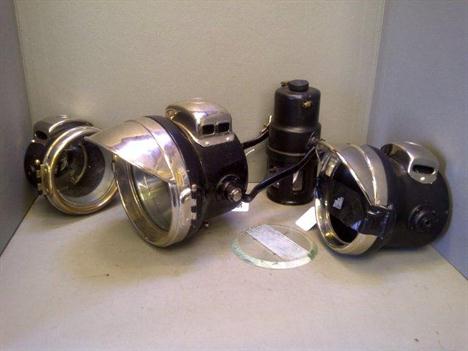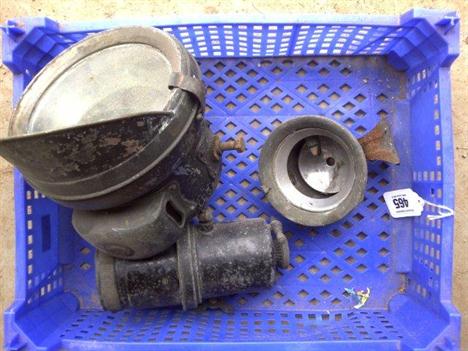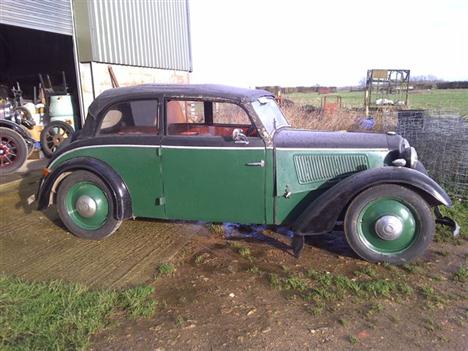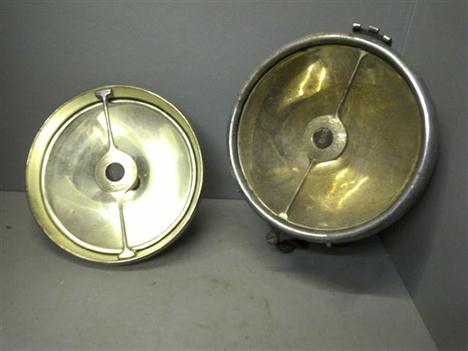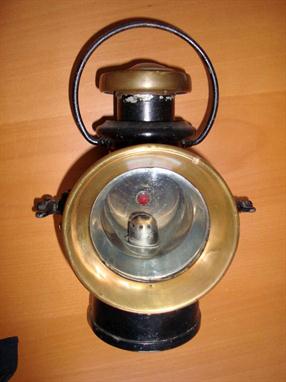We found 1650 price guide item(s) matching your search
There are 1650 lots that match your search criteria. Subscribe now to get instant access to the full price guide service.
Click here to subscribe- List
- Grid
-
1650 item(s)/page
Tipco, Germany, c1928 clockwork motorcycle and pillion female, mechanism needs attention, would clean up well for display, headlamp missing, some rust spotting on faces, rare item, similar pressing to Mickey Mouse & Minnie also in Moses Khonstan`s catalogue of 1928 see page 124 Tin Toys by Jack Tempest (F)
A Pair of Early Scalextric Vintage Cars: a No.C65 Alfa Romeo 8C in blue in overall very good condition, radiator mascot, one front mudguard lamp missing, together with a C64 Bentley in black, some parts missing including front mudguard, headlamp glass and exhaust tailpipe, plus an original C64 box.
Schuco No.5700 Synchromatic Open Packard Car: tinplate, pale green body with cream plastic rear wing sections with gold flashes, red lithographed interior, plastic hubs, plated parts. Battery operated, length 27cm. F, windscreen frame bent and no windscreen glazing, one wing mirror missing, front headlamp loose in socket, signs of age, some corrosion to battery compartment interior. Contained in G box with control wire and steering wheel.
Marx Toys (USA) Siren Police Patrol Car, c.1930`s: large scale pressed steel clockwork model, green with yellow tinprinting and black running boards, rubber tyres, brake acting on rear wheels. Length 38cm, height 14cm. Includes clockwork key and in working order (at time of going to press) Some surface wear and corrosion to rear, part of front headlamp missing but otherwise a clean, bright example.
1958 BSA B33 Bike Year: 1958 Bike Make: BSA Bike Model: B33 Bike Reg No.: YPX 896 Bike Frame No.: FB31-1168 Bike Engine No.: GB33-322 Bike Colour: Red / Black The BSA 350cc B31 and B33 500 cc workhorses originated in immediate post-war years with contemporary modern styling, albeit owing much of their engineering to pre-war progenitors. Always appreciated for their solid and reliable performance these popular models were in the BSA catalogue right up to the end of the fifties, when twins became the fashion and the `thumper` was seen by the motorcyclist as an anachronism, apart that is from the sidecar-lugging fraternity who hadn`t yet got over the demise of rigid frames and girder forks. The motorcyclist himself by this time was almost an anachronism, but most appreciated the simplicity, reliability, economy, power and handling of the last of the big everyday Beesa singles which by 1959 had the benefit of well developed swing arm frame, telescopic forks large fuel tank and copious dual seat. Also by then a fully enclosed rear chaincase, headlamp nacelle, alternator electrics and more effective brakes were standard. As ever the Great British Motorcycle Industry had got it right. Then they stopped making them! This particular B33, dating from the penultimate year of full production, appears to be very original and correct in it`s red/black livery, and has a useful rear carrier fitted. The bike was first registered in West Sussex and spent most of it`s life in the area before being purchased from a farm in Hastings by the vendor in 1994. However restoration never got under way and YPX 968 has been in dry storage since. Swansea V5 plus original buff log book and a 1990 MOT certificate are with the machine, which is a very suitable case for complete rebuild. All parts being freely available from numerous BSA suppliers the machine will repay the effort required as these bikes are much sought after in today`s market. Click Here to view this item on www.i-bidder.com
1956 Douglas Dragonfly Bike Year: 1956 Bike Make: Douglas Bike Model: Dragonfly Bike Reg No.: Un-Reg Bike Frame No.: 1157/6 Bike Engine No.: 1157/6 Bike Colour: Cream Although the Mark series machines had served Douglas well they were replaced in 1955 by a new model, originally to be called the Dart, but by the time of its release known as the Dragonfly. Although the new machine employed an engine that was clearly a development of the existing unit the majority of the mechanical components were revised. The twin carburettors of the Mark series were replaced by a single instrument housed under a cover above the crankcases with the mixture being fed to the cylinder heads by two, long curving inlet manifolds fed from a chamber cast into the clutch housing. The revised power unit was endowed with clean modern lines that complimented a totally new set of cycle parts. The torsion bar rear suspension of the previous models was replaced by a conventional pivoted fork system controlled by a pair of Girling shock absorbers. The frame was of a duplex cradle type with a single top tube and Earles type forks, again controlled by Girling units, were fitted at the front. The most striking feature of the machine was the five gallon fuel tank that extended forwards of the headstock to incorporate the headlamp mounting. Unfortunately Douglas was not in a financially secure position leading to their acquisition by Westinghouse Brake and Signal at the end of 1956 which resulted in motorcycle production ceasing in March 1957. The example offered is presented in the more attractive green and cream livery, black and silver being the other commonly seen livery. It has been the subject of a complete mechanical and cosmetic restoration and is described as running well. Dating from 1956 it displays matching numbers and is offered without documents. Click Here to view this item on www.i-bidder.com
1956 Ariel Square Four Bike Year: 1956 Bike Make: Ariel Bike Model: Square Four Bike Reg No.: 686 XUJ Bike Frame No.: AM421 Bike Engine No.: ML405 Bike Colour: Maroon When "The Motor Cycle" road tested an example of the newly introduced Ariel 4G Mark II Square Four during 1953 they summed up the machine in the following manner "A unique high-performance mount with gentle manners and outstanding acceleration". The Mark II had been introduced for the 1953 season incorporating a revised cylinder head to which two alloy inlet manifolds were bolted with separate exhaust pipes for each cylinder. Square Fours had, since their introduction, suffered from over heating rear cylinders under extreme circumstances which the revised cylinder head largely cured. A further benefit of the new head was an increase in power output to 40 bhp at 5,600rpm. The cycle parts were carried over from the Mark 1 but the colour changed to a light Wedgewood blue for a couple of seasons before reverting to the traditional red livery. A new one gallon oil tank, full width alloy hubs and a headlamp nacelle were introduced for the 1956 season establishing the Square Fours final form. This example was restored during 2009, both cosmetically and mechanically and is a fine example of the Square Four in its final form. The vendor informs us that it runs very well and he believes it to be correct in all major respects. Click Here to view this item on www.i-bidder.com
1955 Triumph 6T Thunderbird Bike Year: 1955 Bike Make: Triumph Bike Model: 6T Thunderbird Bike Reg No.: Un-Reg Bike Frame No.: 66703 Bike Engine No.: 6T66703 Bike Colour: Blue The Thunderbird was a natural progression for the development of the Triumph parallel twin cylinder. Its introduction in 1950 came at a time when the majority of the Meriden marque`s competitors had succeeded in bringing their own 500 twins to the market place and served to place them on the back foot again. The instigation for the Thunderbird`s development is commonly attributed to the demands of the North American market; however, Edward Turner`s deep understanding of the motorcycle market suggests that a 650cc twin was, to a degree, inevitable following the success of the Speed Twin and Tiger 100. The new models cycle parts were essentially the same as those employed by the 500 twins in the range with a rigid frame, a "sprung hub" being offered as an option, headlamp nacelle and tank top luggage grid all being carried over from the 500`s. For 1952 an SU carburettor replaced the Amal unit previously fitted and 1954 saw the introduction of an alternator. For 1955 the pivoted fork frame first seen on the sporting Tiger models of the previous season was introduced, the result being arguably one of the most attractive machines to emanate from Triumph. This example, featuring matching numbers was the subject of a cosmetic and mechanical restoration carried out during 2005. It is offered with a green continuation log book. Click Here to view this item on www.i-bidder.com
1935 Singer Nine Le Mans `Longtail` Car Year: 1935 Car Manufacturer: Singer Car Model: Nine Le Mans `Longtail` Car Reg No.: ALV 964 Car Chassis No.: 63855 Car Colour: Green Suitably encouraged by its enviable motorsport achievements of the 1932 and 1933 seasons, Singer created a special Le Mans version of the 9 Sports with a two-seater body mounted on an under-slung chassis - at ú215 it was ú30 dearer than the standard car. Power came from a further uprated version of the Sport`s 972cc OHC engine that featured high lift harmonic cams, a counterbalanced crankshaft and extra-large capacity ribbed oil sump for better cooling. Other drivetrain modifications included a heavy duty clutch and a still closer ratio gearbox. Its rakish bodywork was underpinned by a robust ladder-frame chassis that featured semi-elliptic leaf-sprung suspension all-round, adjustable Andre-Hartford friction dampers and four-wheel Lockheed hydraulic 10-inch drum brakes. Among the optional equipment were tailored suitcases, bonnet strap, route card holder, competition number plates and a combined stop watch and chronometer. Appreciating that some of the customers clamouring for the performance of the Le Mans model needed a sports car with more than two seats, the company introduced a limited run of four-seater examples during the 1935 model year. Effectively a hybrid of the Le Mans and the 9 Sports, they featured upswept cowl scuttles and a streamlined (`Long`) tail. According to its accompanying copy build record, this particular example was supplied new by the Newsham Motor Company of Liverpool to C.K. Williams Esq of Leopold Road, Waterloo on August 3rd 1935. A Liverpool resident ever since, the Singer passed to its second keeper Ray Stokes - President of the Chester Vintage Car Club - in 1967. Stripped down circa eight years later, the Nine`s restoration proved a long drawn out affair that was only completed by Mr Stokes` daughter last year (the car had originally been intended as her twenty-first birthday present). The work included: some attention to the engine; a new exhaust; body off respray; retrim; new carpets, hood and tonneau cover, and repainted wire wheels. Complete with such period niceties as headlamp grilles, badge bar, scuttle light, bonnet strap etc, `ALV 964` is now ready for a new owner to enjoy. Click Here to view this item on www.i-bidder.com
1937 DKW F7 Meisterklasse Cabriolet Reg. No.: DOX 468 Chassis no. 5064535 Engine No.: 762816 DKW is a historic German car and motorcycle marque whose name derives from ‘Dampf-Kraft-Wagen’, the German for steam driven car. Indeed it was a steam driven car that was attempted in 1916 by a Danish Engineer who had founded a factory in Saxony to produce steam fittings that same year. Although unsuccessful he made a two stroke toy engine in 1919 and put a modified version of this engine into a motorcycle. This was the real beginning of the DKW brand. By the 1930’s DKW was the world’s largest motorcycle manufacturer. In 1932 DKW merged with Audi, Horch and Wanderer to form the ‘Auto Union’. DKW cars were made from 1928 until 1966, always using two stroke engines and from 1931 the company was a pioneer in front wheel drive and transverse mounting. The ‘F’ prefix series signified front wheel drive and these cars were powered by 600 or 700cc engines. The F7 model, of which we have an example here, was made between 1937 and 1938. This motorcar was made late in 1937 and registered early in 1938. It has been owned by the same family since 1962 and is believed to have been rebuilt in 1955 by a previous owner. At this time a number of modifications were carried out such as the addition of trafficators, side lights and a temperature gauge. Lucas headlamp lenses were also fitted to the original shells. This car has been a regular attendant at owners club meets from the 1960’s-1980’s and has always been garaged. Currently MOT’d it is in running but unrestored condition. It would benefit from some improvement, and we are advised that it could do with a re-wire. A rare opportunity to acquire a seldom seen motorcar. Please note there are a number of DKW spares from the same vendor, in the sale on Day 1. Click Here to view this item on www.i-bidder.com
A J.H. Glasman (`Betal`) `General Transport` motor bus tinplate toy, red and cream with a silver roof, carrying advertisments for `Walter`s Palm Toffee` (near-side), `Bisto` (off-side) and `Shredded Wheat` (rear), with a clockwork mechanism and battery-operated cyclops headlamp, complete with key, generally good condition (rust to roof; lacking headlamp bulb and with untested wiring), in working order, 27cm long, unboxed. [L] Literature: A rarer trolley-bus variant is pictured in Jack Tempest, Collecting Tin Toys (1987), pp.60-61. See also Marguerite Fawdry, British Tin Toys (1990), p.60.
Assorted motorcycle parts, including a new (old stock) ex War Department headlamp with Lucas lens and switches; a new (old stock) headlamp with Lucas lens; another headlamp with Lucas lens and switches; various electricals; a B.S.A. gearbox; a Burman gearbox; an incomplete Ariel engine; three various cylinder heads; various valves, springs and collets; and various gearbox, clutch and cycle parts. Note: This lot can be viewed at our Baynton Road saleroom, Ashton, Bristol, BS3 2EB, during the stated view times.
Tri-ang Minic tinplate vehicles: Refuse trucks with green cab (1) and red cab with Shell petrol can (1), Transport Lorry with green tilt (1) and red tilt (1), Petro tanker with blue cab and red tank, Breakdown truck with green cab and red back, Road roller, green with plastic wheels, Vauxhall tourer green and black, and pre-war limousine plated arches and running board and maroon body with Shell petrol can, electric Caravan in cream with green lower body, P-F all clockwork mechanism tested, Vauxhall lacks headlamp. roller lacks Chimney, green lorry tilt lacks one door, red tilt lack front (10)
A Meccano clockwork No. 1 Constructor Car, constructed as blue and cream Sports Tourer, with spare Sports Body, Tonneau Cover, Folded Hood and pair of Doors, with key and two spanners and two other keys, overall F-G, some foxing, headlamp lenses warped, paint loss to rear of Saloon Body from previously glued spare wheel (6)
Assorted Dinky models, circa 1950s-60s, including a Dinky No.40H, Austin Taxi, yellow, with matching ridged hubs, fair-playworn condition; Dinky No.36a, Armstrong Siddeley, grey over black, playworn (lacking one headlamp); Dinky No.430, Commer Breakdown Truck, tan and green, with red ridged hubs, fair-good condition; Dinky No.734, Supermarine Swift, green-grey camouflage finish, good condition; and twenty other road vehicles and aircraft, variable condition, all unboxed, (24).
A group of twelve immediate post war unboxed Dinky Toys, models include a Fire Engine, complete with ladder and bell, a Taxi in maroon and black, a Royal Mail post office van, a Petrol Tanker, Market Gardener`s Lorry, a Flat Truck, an Army Scout car, a tractor with limber and gun, a trailer and a pre war lorry and trailer with white wheels (one headlamp missing)
A COLLECTION OF VARIOUS PARTS FOR MG MMM (FITS SEVERAL MODELS), including rear axle casing, 3 x steering wheel, 4 x head lamps, 9 x wire wheels, 3 x horns, starter motor, small Hartford shock absorbers, 2 x headlamp glasses, 2 x headlamp shells, new, wheel nut, 4 x door hinges, 2 x front chassis cross member, radiator mounting brackets and rocker cover (6 cylinder engine).
-
1650 item(s)/page
